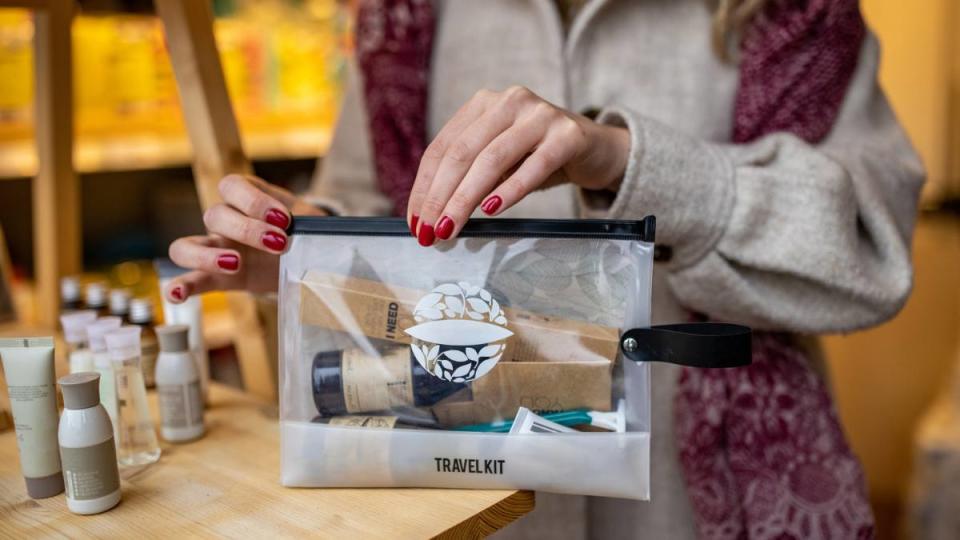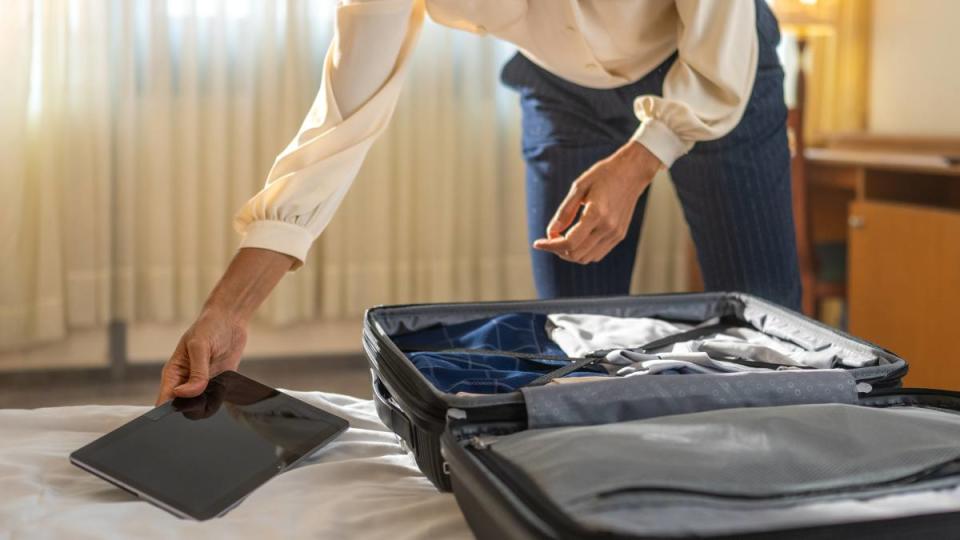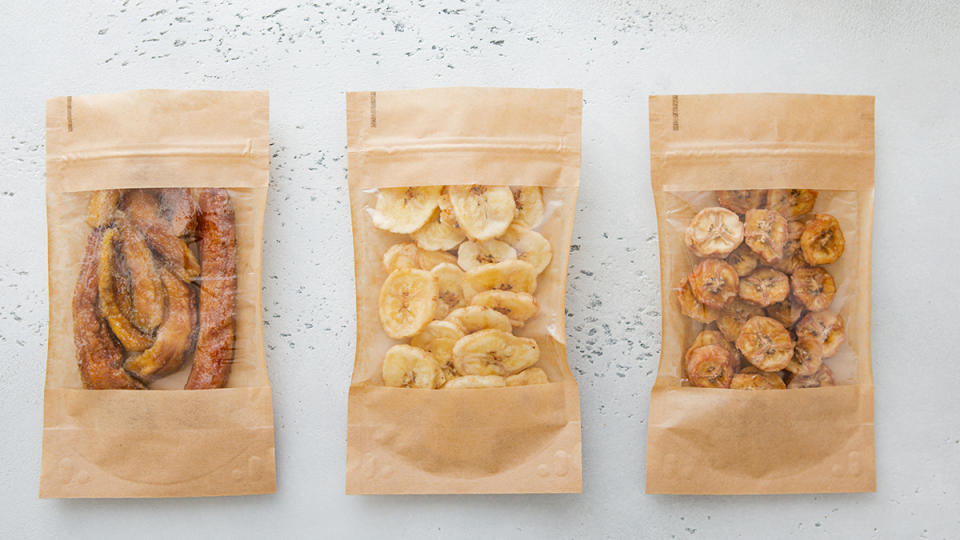What to Bring for a Hospital Stay, Including the Low-Tech Gadget Patients Swear By
After all the appointments, tests and scheduling, your surgery date is almost here…and you’re staring at an empty bag wondering what to bring to the hospital. “Taking the time to get organized, think about the details of your procedure and anticipate your needs pays off every time,” encourages Stephanie Lanier, a veteran of more than a dozen hospital stays of many lengths with her medically fragile son, Oliver. “The good news is that many of the most helpful items are relatively small and can make a huge difference to your comfort, mood and outlook. And just the act of packing strategically will give you a sense of calm and control.” We asked her and other experts what to bring to hospital. Read on for their must-haves.
What to bring to hospital: Comfort items
You’ll rely on these items practically all the time, and they can be hard to purchase at the gift shop:
A plush blanket: “A cozy blanket is a true essential because hospital versions are almost always thin cotton, and you’ll want the extra warmth and security,” says Lanier. Thick fleece, temperature-regulating bamboo and even faux fur are great options. (Learn more about why you may want to bring a weighted blanket.)
Your own pillow: “I always bring my own pillows and use brightly colored pillowcases so they don’t get mixed up with hospital linen,” says Lanier.
Nonconstricting clothing: Choose soft, loose garments that will allow nurses to easily check your blood pressure and access your IV or surgical site. For an abdominal surgery, try yoga pants with a foldover waistband that you can adjust. A robe keeps you warm and covered as you walk the halls and zip-up styles are easier than fiddling with a belt. Finally, a soft-cup bra is comfortable enough to sleep in while still offering support.
Cozy socks: Unlike blankets, hospital-provided socks can be amazing, with great grippers for traction. But it’s worth bringing a few of your own just in case.
Back scratcher: On a Reddit thread about planning for a weeklong hospital stay, several commenters shared the same #1 essential: a back scratcher to get at any itches that may be hard to reach!
Pack these freshen-up essentials

When you can’t shower due to mobility, wound healing or lack of facilities, these toiletries are the next best thing:
Cleansing wipes: Single-use wipes are a must, but not all are created equal. You’ll want something gentle you can use on sensitive areas, such as WaterWipes, Cottonelle or Megafresh “down there” wipes, plus something potent for underarms and feet. Herban Essentials wipes boast essential oils like lemon, eucalyptus and peppermint that will revive your mind and body.
A richer moisturizer: “Remember that hospital air can be super-dry because of all the filtration,” says Lanier. “Even if you don’t usually need moisturizer or lip balm, you’ll be glad you have it. And if you already use lotion, consider upgrading to a thicker cream or balm.”
Related: 8 Best Moisturizers for Rosacea-Prone Skin, According to DermatologistsSaline nasal spray: Dry air affects your nose and sinuses, too. A few spritzes of saline will keep ‘em hydrated.
All the oral care: Often when we pack our toiletries we think we can do with just a toothbrush and toothpaste since it’s just a few days. But between the dry air, medications and different foods, your mouth needs all the TLC it can get. So pack your favorite flossers, tongue scraper, mouthwash and mouthguard if you use one.
Nail clippers or cuticle cutters: Don’t let a hangnail or broken nail drive you crazy.
A shampoo substitute: For short stays, you can brush dry shampoo through hair to lift away oils and add volume. (Pick up a a travel-size bottle.) For longer stays, Lanier suggests looking into waterless, no-rinse shampoo caps. These nifty inventions contain shampoo and a light conditioner that you or a nurse massage into your hair. You can even heat your cap in the microwave for a well-deserved bit of indulgence.
Related: Is Dry Shampoo Bad for Hair? Experts Weigh In + How to Pick the Best One for You
What to bring to hospital: Have a sleep-better strategy
When we asked an oncology nurse at MedStar Georgetown University Hospital to share her tips on a comfortable stay, shuteye was a top priority. “Getting sleep in the hospital can be tough. Depending on your medical needs, you may be woken up more frequently to check your vital signs or to take medications. It’s smart to ask your care team if they can cluster your care — for example, take vital signs at the same time as giving you medications.” She also recommends thinking about blocking disruptive light and sound. “Many of the noises and lights in the hospital are needed for safety reasons and can’t be avoided, but packing these items can make a big difference to your sleep quality.”
Ear plugs & sound machine: Muffle the sounds of rolling carts and foot traffic with a double whammy of earplugs and a portable white noise machine. Also, ask your nurse if you can lower the sound on any beeping machines — many are automatically on the loudest setting but don’t need to be.
Related: Green Noise May Be the Surprise Secret to Deep Sleep — Plus More Healing SoundsEye mask: Some rooms have great shades but others are hard to darken, so pack an eye mask to lessen the shock of lights flipping on.
Small fan: Most hospital rooms have a thermostat, but if yours is wonky or you end up sharing a room, a small rechargeable fan will keep you cool overnight.
What to bring to hospital: Pack plenty of boredom busters

The hospital just may be the one place we don’t have to feel guilty about overusing our digital devices! Make the most of it with the right accessories — and a few old-school options for when you’re tired of tech:
An extra-long phone charger: “Phone chargers are a must, and the longer the better to get around machines and access outlets,” says Anita Abdeen, MSN, RN, NE-BC, Senior Director of Nursing Operations & Patient Care Services, Pediatric and Perinatal, MedStar Georgetown University Hospital. Between 5 and 10 feet is ideal.
Wireless headphones: It’s much easier to listen to music or watch a show without a cord.
Phone or tablet stand: Avoid neck pain and eye strain with a holder or dock for your tablet or phone. A pillow-like model will be the most adjustable as you shift positions.
Pre-downloaded content: Wifi can be awful in hospitals, so download a bunch of movies, shows and podcasts before you’re admitted.
Video games: If you’re new to gaming, try the mindless fun of Cat Quest, go retro with Tetris or download Animal Crossing: Pocket Camp to experience the most popular game for women.
A new-to-you craft: Trendy cross stitch is more self-contained than knitting or crochet, and easy for a beginner to learn. Or try a single-use watercolor set that comes with a drawing, brush and just enough paint for one pretty project.
What to bring to hospital: Organize essentials
It’s great to take notes on your phone, but writing things down and printing key documents can be more effective in a hospital setting. Make sure to pack:
Notepad and pens: “Take notes and then more notes!” encourages Lanier. “Clinicians can disagree with each other and you want to keep track of everything.” Feel particularly supported by a nurse or other staff member? Write down her name in case you need an advocate, and so you can mention her in any patient satisfaction surveys.
Printed medication list: “Having an up-to-date, printed medication list can be lifesaving,” emphasizes Lanier. “It helps in so many ways as you navigate specialists, coordinate with pharmacies and move to outpatient care.” You can triple-check doses and delivery methods at a glance and catch any oversights. If your dosages are fluctuating, you may want to use a template to keep track.
Mini Post-it notes: “I use these all the time in the hospital: to make symptom charts I can stick on the wall, track schedules and even make small calendars I can take home,” says Lanier. “For complicated followup care, use different colors for specific medications or interventions or add icons. Visual evidence is very persuasive in a medical setting.”
Day-of instructions: Hospitals can seem like sprawling, construction-filled labyrinths. Ask your doctor’s assistant for a detailed set of directions so you know where to park and where to report on the day of your procedure. And take a photo of where you parked, says Lanier. “Trust me, you won’t remember a few days later!”
A list of questions: Have a list of discharge questions ready before you head to the hospital. This lets you take advantage of the “in-patient advantage” — the increased ease of asking questions, requesting referrals, securing refills, researching rehab facilities and making appointments while you’re physically in the hospital rather than as an outpatient calling an operator. “It’s especially important to ask for proper training if you’re going home with new-to-you medications or devices,” says Lanier.
What to bring to hospital: Choose savvy snacks

To support your healing and treat your tastebuds, pack an assortment of non-perishable nibbles, including…
Protein and healthy fat snack packs: Shop for pouches of pitted green olives, peanut butter packets, Parmesan crisps, sleeves of instant oatmeal, dried edamame beans, seaweed snacks and easy-to-peel clementines.
Drink mixes: Individual drink mix packets are especially helpful if you’re only allowed liquids; simple teas are usually fine but avoid herbal blends to avoid interactions.
Shelf-stable milk: You can find your favorite dairy, nut, seed and flavored milks in small to-go cartons that don’t need refrigeration. (Note that many hospital room fridges have tiny freezers you may notice at first glance.)
Prune products: It’s always smart to ask your nurse about preventing constipation (a common side effect of pain medication and anesthesia) before it starts. Pureed prune baby food pouches are an easy way to support healthy bowel movements.
Tip! Get the scoop on snacks! “I wait until I can casually chat with a long-term nurse—not a travelling nurse—to ask for insider info on snacks, cafeterias, vending machines and nearby eateries at deliver to the hospital,” shares Lanier. Also inquire about the best way to order meals to your room. “At many hospitals, ordering an hour before you want to eat is the worst strategy. If you can, order all your meals at once in the morning.”
Include housekeeping items and homey touches
Keeping your hospital room tidy and adding personal touches will boost your mode. Our experts suggest bringing…
A large collapsible tote: “Changing rooms can happen during a hospital stay, and it’s helpful to have a way to corral smaller items,” shares Abdeen. “You can also use the tote to bring home any devices or extra items you receive as gifts.”
A bag for laundry
A bedside caddy: Keep essentials in arm’s reach with a hanging organizer bag you can attach to one side of your hospital bed. You may already have something similar in your car or garden.
A potted plant: “When my grandmother was hospitalized, I picked up a potted cyclamen at Trader Joe’s on a whim,” shares Lanier. “It turned out to be such a beautiful enhancement to her room. It added brightness and light, started conversations and was easier to tend to than cut flowers. Plus, you can bring plants home with you after discharge — like a moveable garden!”
Family photos: “If you’re going to be hospitalized for an extended period of time, bringing photos can be a nice way to make the room feel more homey and less sterile,” shares the oncology RN we spoke with. Lanier agrees: “When my friend Lisa was in treatment for brain cancer and immunocompromised, many items weren’t allowed. Instead of flowers, we made her a customized washable fleece blanket covered with photos of her loved ones. It surrounded her with love while meeting all the safety requirements of her intense treatment.”

